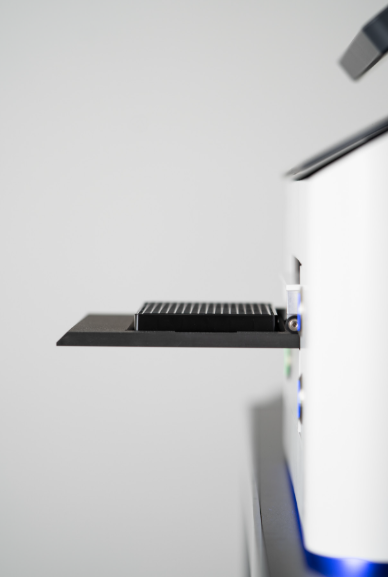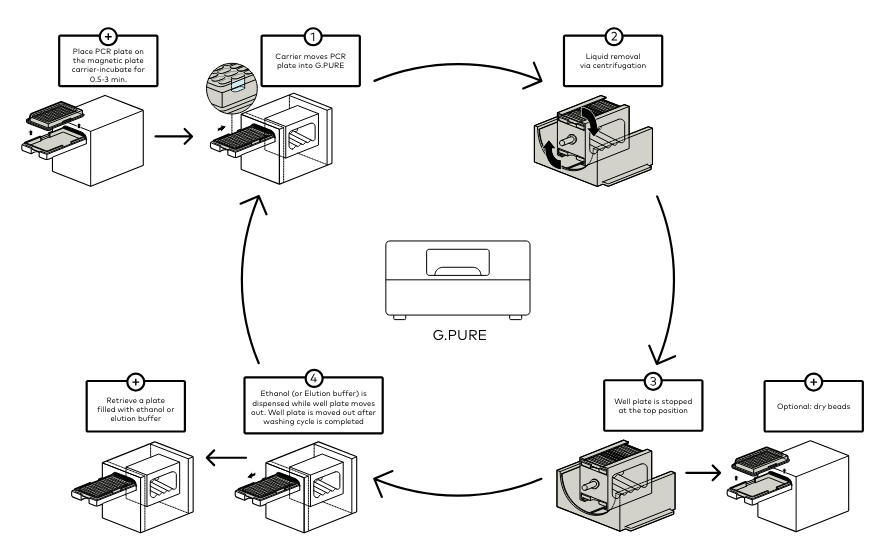Few modern technological developments are more revolutionary than next-generation sequencing (NGS). This technique has opened doors to a fresh understanding of the genome and helped generate novel therapies, particularly in precision medicine and diagnostics1.
Despite its revolutionary potential, NGS is not without its challenges. Amazing research questions ultimately face the bottleneck of the NGS workflow. This workflow is often repetitive, labor-intensive, time-consuming, and can be a source of frustration (to put it mildly). The complexity of the process leaves little room for error, and even a tiny slip-up during library preparation can lead to misleading data later on.
This is where the I.DOT Liquid Handler and the G.PURE NGS Clean-Up Device come in, offering an automated solution that can save you time and money while ensuring accuracy in NGS experiments. Here, we will dive into how the I.DOT Liquid Handler and the G.PURE NGS Clean-Up Device can revamp your prep for NGS.
Introducing Automation for Streamlined NGS
NGS has transformed healthcare research, and automation is now primed to transform how we perform NGS2. At the core of this new wave are the I.DOT Liquid Handler and the G.PURE NGS Clean-Up Device which enable faster and more accurate processing for a broad range of techniques, including RNA-Seq and ChIP-Seq.
The I.DOT Liquid Handler is your primary tool for fast and accurate liquid dispensing. It is compatible with various plate types and formats and even helps with protocol optimization (Fig. 1).

Manual sample prep and clean-up contribute to prolonged NGS workflows and unreliable data3. The G.PURE NGS Clean-Up Device solves this problem by providing an automated and reproducible method for clean-up, letting you get the most out of your precious samples.

Figure 1. The I.DOT Liquid Handler supports a range of plate formats and sequencing applications.
Automating up to 80% of Your NGS Workflow
In modern healthcare research, researchers constantly aim to generate a higher volume of high-quality data with faster turnaround times. The I.DOT Liquid Handler and the G.PURE NGS Clean-Up Device offer the ultimate solution for streamlining NGS workflows (Fig. 2). Here are some key benefits users can expect from these devices:

Figure 2. The G.PURE NGS Clean-Up Device provides a streamlined, automated method for generating a high yield of pure, uncontaminated samples.
I.DOT Liquid Handler
- Batch processing. Enables high-throughput NGS workflows to significantly reduce turnaround times.
- DropDetection technology. Enables detection and counting of every droplet released during a run.
- Minimal dead volume. Ensures a maximum of 1 µL dead volume for efficient reagent conservation.
- Non-contact dispensing. Eliminates the chances of cross-contamination, ensuring high-quality samples and data.
- Protocol creation. The built-in Assay studio helps you design optimal protocols for your workflow.
- Supports minimization. Accurately dispenses volumes as low as 8 nL, allowing you to scale down and save money4.
G.PURE NGS Clean-Up Device
- High-quality libraries. Magnetic carriers and automated washing ensure high yield and guarantee quality.
- User-defined. The device is fully programmable to user specifications, allowing it to fit seamlessly into a predefined NGS workflow.
- Reproducible. Once your protocol is optimized, the G.PURE NGS Clean-Up Device enables maximum reproducibility at the touch of a button.
- Sustainable. The G.PURE NGS Clean-Up Device minimizes the need for pipette tips, offering a sustainable solution for NGS library prep5.
The Benefits of Automation
The power of automated technologies cannot be overstated, especially with intensive and error-prone techniques such as NGS6. The challenges of modern healthcare research demand modern solutions that let scientists do what they do best.
Free Up Valuable Time for Analysis and Discovery
Science is about generating discoveries that benefit humanity, not getting irritated over tedious manual pipetting tasks. Automation allows scientists to use their time to develop new ideas and analyze data to extract exciting insights. In short, it lets scientists be scientists.
Increased Throughput and Productivity
Academic and private healthcare are highly competitive fields where time is often the most valuable resource. Automation helps to streamline research efforts7, generating faster results and giving researchers an edge over the competition.
Improved Consistency and Data Quality
Automation significantly diminishes the impact of human error on data integrity. Consistent workflows enable scientists to draw conclusions from their data with more confidence. High-quality data is essential for furthering research and providing the basis for new therapies8.
Conclusion
NGS is a pivotal advancement in healthcare research, unlocking unprecedented insights into the genome and driving innovations in precision medicine and diagnostics. However, traditional NGS workflows' laborious and error-prone nature presents a significant obstacle.
The I.DOT Liquid Handler and the G.PURE NGS Clean-Up Device are game-changers in NGS workflows. By automating up to 80% of the NGS workflow, these tools offer researchers invaluable benefits such as increased throughput, enhanced productivity, and improved data consistency and quality.
Ultimately, automation liberates scientists from mundane tasks, allowing them to focus on analysis, innovation, and pursuing transformative discoveries that benefit everyone.
Ready to unlock the full potential of your NGS workflow? Learn how automation can take your research to the next level and book a demo today!
References
- Grada A, Weinbrecht K. Next-Generation Sequencing: Methodology and Application. J Invest Dermatol. 2013;133(8):1-4. doi:10.1038/jid.2013.248
- Socea JN, Stone VN, Qian X, Gibbs PL, Levinson KJ. Implementing laboratory automation for next-generation sequencing: benefits and challenges for library preparation. Front Public Health. 2023;11(1195581). doi:10.3389/fpubh.2023.1195581
- Guan XL, Chang DPS, Mok ZX, Lee B. Assessing variations in manual pipetting: An under-investigated requirement of good laboratory practice. J Mass Spectrom Adv Clin Lab. 2023;30:25-29. doi:10.1016/j.jmsacl.2023.09.001
- Melo MR, Clark S, Barrio D. Miniaturization and globalization of clinical laboratory activities. cclm. 2011;49(4):581-586. doi:10.1515/CCLM.2011.092
- Bistulfi G. Reduce, reuse and recycle lab waste. Nature. 2013;502(7470):170-170. doi:10.1038/502170a
- Torres-Acosta MA, Lye GJ, Dikicioglu D. Automated liquid-handling operations for robust, resilient, and efficient bio-based laboratory practices. Biochem Eng J. 2022;188(108713). doi:10.1016/j.bej.2022.108713
- Thurow K. Strategies for automating analytical and bioanalytical laboratories. Anal Bioanal Chem. 2023;415(21):5057-5066. doi:10.1007/s00216-023-04727-2
- Endrullat C, Glökler J, Franke P, Frohme M. Standardization and quality management in next-generation sequencing. Appl Transl Genomics. 2016;10:2-9. doi:10.1016/j.atg.2016.06.001